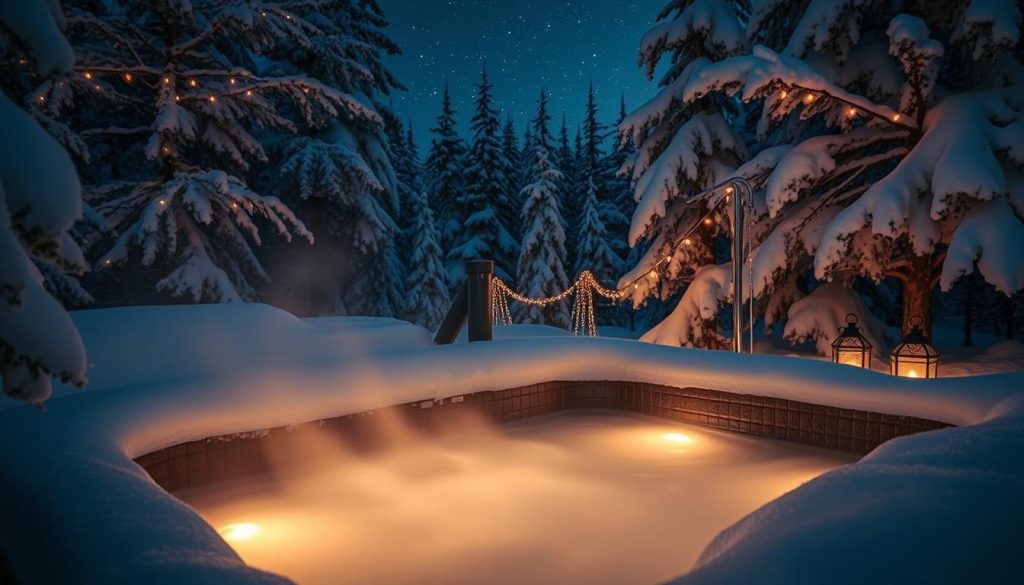
Most hot tubs lose about 60% of their heat through the water’s surface. This fact shows why it’s crucial to understand hot tub heating time. On average, hot tubs take four to six hours to reach the desired temperature.
Water in a hot tub warms up at a rate of 3°C to 6°C per hour. However, the actual heating time can vary based on several factors.
The size of the hot tub affects how quickly it heats up. Smaller tubs generally warm faster than larger ones. Insulation quality also plays a big role in heating time.
Ambient temperature and component efficiency impact heating duration too. Fully insulated models with high-quality foam can significantly reduce the time needed to reach the desired temperature.
Factors Affecting Hot Tub Heating Time
Many things can change how long a hot tub takes to heat up. Knowing these can help you pick and care for your hot tub better. This leads to a more fun and efficient experience.
Hot Tub Size and Water Volume
The hot tub’s size and water amount affect heating time. Smaller tubs with less water heat up faster than bigger ones. A two-person tub with 795 liters of water heats in about 8 hours.
A larger six-person tub with 1,667 liters may take up to 17 hours. Both use the same 2.7kW heater.
| Hot Tub Model | Water Volume (Liters) | Heater Power (kW) | Heating Time (Hours) |
|---|---|---|---|
| Jacuzzi® J-315™ | 795 | 2.7 | 8 |
| Jacuzzi® J-335™ | 1,325 | 2.7 | 14 |
| Jacuzzi® J-475™ | 1,667 | 2.7 | 17 |
Ambient Temperature and Weather Conditions
The outside temperature and weather affect heating time. In cold climates or winter, the hot tub needs more time to heat up. Hot tubs heat in 2-5 hours during summer, compared to 3-8 hours in winter.
Wind can cool the water’s surface, causing heat loss. Placing the tub in a sheltered area or using windbreaks can help heating.

Hot Tub Insulation and Cover Quality
Good insulation and a quality cover help keep heat in your hot tub. Well-insulated tubs with thick, snug-fitting covers heat up faster and better. A cover at least four inches thick with a heat seal can cut heating times.
Heater and Pump Efficiency
The hot tub’s heater and pump power affect heating time. A stronger 6kW heater can heat water faster than a 2.7kW one. A good pump moves heated water evenly, preventing cold spots.
Regular upkeep of these parts can improve performance and reduce heating times.
Understanding these factors helps us make smart choices about hot tubs. This leads to a more enjoyable and energy-efficient experience.
Tips to Speed Up Hot Tub Heating Time
You can speed up your hot tub’s heating process and boost its efficiency. These tips will help you enjoy your hot tub sooner and with greater peace of mind.
Proper Maintenance and Servicing
Regular hot tub upkeep ensures optimal heating efficiency. Keep your hot tub in top shape to minimize heating time and enhance your soaking experience.
Clean and replace filters to maintain proper water flow. This reduces strain on the heater. Maintain proper water chemistry to prevent damage and optimize heat transfer.
Schedule yearly professional servicing to inspect and tune up critical components. This includes the heater, pump, and other important parts.
- Cleaning and replacing filters as needed to maintain proper water circulation and reduce strain on the heater
- Maintaining proper water chemistry to prevent damage to components and optimize heat transfer
- Scheduling professional servicing at least once a year to inspect and tune up the heater, pump, and other critical components
Studies show that regular maintenance improves heating efficiency. Clean filters and circulating pumps optimize heating performance.
Use a Hot Tub Cover and Thermal Blanket
A high-quality, insulated hot tub cover speeds up heating time. It also retains heat between uses. A proper cover reduces heat loss, as 60% escapes from the water’s surface.
A thermal blanket floating on the water’s surface enhances heat retention. This further minimizes heating time.
Using a hot tub cover can help the tub warm up faster and run more efficiently, reducing the time it takes to reach your desired temperature.
Optimize Your Hot Tub’s Placement
Your hot tub’s location affects its heating efficiency. Place it in a sheltered area to reduce heat loss and improve heating time.
Position your hot tub in a natural alcove or use windscreens. Hedges or enclosures can create a barrier against the elements.
- Position your hot tub in a natural alcove or install windscreens, hedges, or enclosures to create a barrier against the elements
- Avoid placing your hot tub in exposed, windy areas that can rapidly dissipate heat
- If possible, locate your hot tub in a spot that receives ample sunlight during the day to naturally warm the water
Optimizing placement improves heating efficiency and enhances your soaking experience. Choose a location with ample sunlight to naturally warm the water.
The landscape around your hot tub impacts heating efficiency. Wind exposure can affect heating, so choose your location wisely.
Conclusion
Hot tub heating time varies based on size, temperature, insulation, and heater efficiency. Smaller acrylic tubs warm up in 3-8 hours. Larger or wooden tubs may need 12-24 hours. Good maintenance and insulation lead to faster heating and energy savings.
To speed up heating, invest in a well-fitted cover and thermal blanket. Place your tub in a sheltered spot away from winds. These steps will boost heating efficiency and cut energy costs.
Don’t rush the heating process. Allow enough time for proper warming. This ensures energy efficiency and extends your spa’s life. With care, you’ll enjoy a perfectly heated tub whenever you want.







